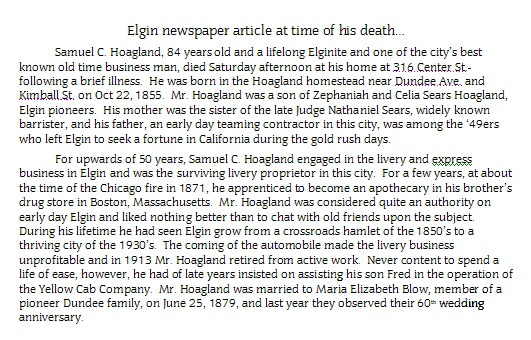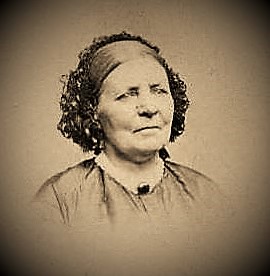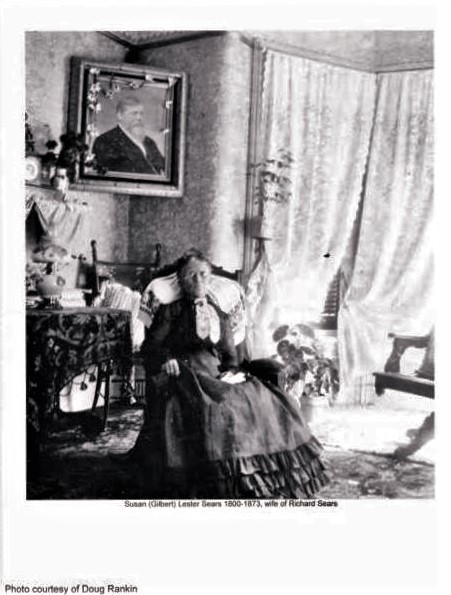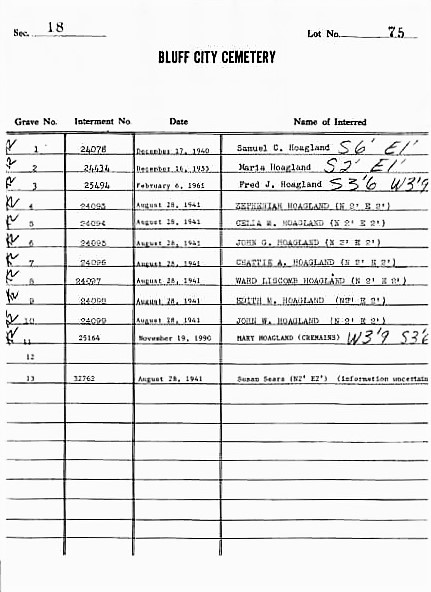Fred Judson Hoagland
Samuel Campbell Hoagland 1855–1940, Early Elgin, Illinois, Livery and Transportation
“Sam was a prudent businessman who maintained a card index of every animal and piece of equipment. He retired in 1913. He owned 26 horses, 11 full-sized closed carriages, 3 hearses, 3 fancy conveyances, opera hacks, pallbearer wagons, two seat carriages and one-seat light driving rig.”
Wagons to taxicabs: 4 generations of Hoaglands haul Elginites by E. C. Mike Alft
Samuel Campbell Hoagland was my great great grandfather.
son of Samuel Campbell HOAGLAND
daughter of Frederick Judson “Fred” HOAGLAND
son of Helen Marie HOAGLAND
the daughter of Capt. Frank Hunt BOSWORTH II
Samuel Campbell Hoagland was born on December 22, 1855, in Elgin, Illinois. His parents were Zephaniah and Celia (Sears) Hoagland.
Sam married Maria Elizabeth Blow on June 25, 1879 in his hometown. According to family history notes by my grandmother, the couple was married at the residence of D.R. Jencks, Rev. D.B. Cheney officiating. However, Robert B. Mogler, another Sam Hoagland descendant, has stated their marriage certificate shows they were married a the First Baptist Church in Elgin. They had two children during their marriage, a son Frederick Judson “Fred,” was born on June 12, 1880, and a daughter, Jennie May “Jane,”born on November 14, 1881. Both children were born in Elgin.
Hoaglands
For more than a century, through four generations and changing modes of transportation, the Hoaglands hauled freight and people around Elgin.
Zephania Hoagland’s aunt and uncle pioneered east of town in Hanover Township in 1837. Born in Steuben County, New York, Zeph also was an early arrival here, but didn’t settle down in Elgin until he had tried his luck as a’49er seeking gold in California. Zepbania became a teamster whose horse-drawn wagon carried goods around the little mill town that grew into an industrial city during his lifetime.
Zeph’s son, Sam C. Hoagland, was born in Elgin in 1855. He worked for his father and then purchased his own one-horse express wagon in 1876. The livery (a stable keeping horses and vehicles for hire) he bought four years later became one of Elgin=s largest. He also ran buses to and from the factories and supplied a big Tally-Ho wagon for picnics.
Sam Hoagland was a prudent businessman who maintained a card index on the cost of every animal and piece of equipment in his stable. His records indicated what each horse had eaten and earned. He also knew each one’s habits. When a drummer had rented a rig to go to Dundee, be complained on returning that the horse had balked. Sam charged him more than originally agreed because the rig had gone all the way to Algonquin. How did Sam know? Old Betsy never stalled except on the Algonquin bill.
Some customers desired well-dressed drivers as well as a carnage. In the Hoagland wardrooms were 15 outfits of fur coats, gloves, and caps. There were enough neatly brushed silk hats to costume a half-dozen minstrel shows.
By the time be retired in 1913, Sam Hoagland owned 26 horses, 11 full-sized closed carriages, three hearses, three fancy conveyances, opera hacks, pallbearer wagons, two-seat carriages, picnic wagons, and one-seat light driving rigs of all descriptions.
Sam’s son, Fred J. Hoagland, was born in Elgin in 1880 and joined the business after leaving high school. When the livery closed, he adapted to the motor age and started the Hoagland Taxicab Company with three Model-T Fords and two Reos, all black. Meters were introduced in 1919, and the original fare they tallied was 25 cents for the first mile and 10 cents for each succeeding two-fifths mile. After World War I, Fred began buying Yellow cabs manufactured in Chicago by John Hertz, and the firm’s name was changed to the Elgin Yellow Cab Company.
The early Yellows had tonneaus in which only the passenger compartment was enclosed. The driver was in the open air, exposed to rain and snow. After Hertz sold out to General Motors, Hoagland switched to Chevrolets.
Two-way radios, which reduced cost and response time, were introduced in 1946. At its operating peak in the 1950s, Elgin Yellow had about 60 full and part-time employees, including three full time dispatchers, two telephone operators, maintenance shop repairmen, and drivers. The firm had 18 cars on the streets in the summer and 25 in the winter. The cars averaged about 7,000 mile per month. Eight new cars were purchased each year. By the end of the decade, Elgin Yellow had switched from Chevrolets to Checkers made in Kalamazoo, Michigan.
Fred’s son, Charles Hoagland, was born in Elgin in 1913. While still a boy, he learned the ropes by guiding new drivers around the city. He eventually became a partner in the business, withdrawing in 1964, but was driving his private livery until he reached the age of 70.
—–
ElginHistory.com – Elgin: Days Gone By – E. C. Alft
At the age of 84 years old, Sam died and was buried, alongide his wife, Maria, in Elgin’s Bluffside Cemetery. The following was transcribed by my grandmother, Helen Marie Hoagland who was his granddaughter, from a newspaper article at the time of his death. She did not state the source of the death notice:

Susan (Gilbert) Sears Lester 1800–1873
Susan GILBERT

Susan Gilbert
1800–1873
My fourth great grandmother
daughter of Susan GILBERT
son of Celia Mary SEARS
son of Samuel Campbell HOAGLAND
daughter of Frederick Judson “Fred” HOAGLAND
son of Helen Marie HOAGLAND
the daughter of Capt. Frank Hunt BOSWORTH II
Susan was buried in Elgin first in Channing Cemetery, then her remains were transferred after the historical closing of that cemetery, to Bluff City Cemetery, where her daughter, Celia Mary (Sears) Hoagland is buried. She is buried in one mass grave with other family members as noted on the interment document from Bluff City Cemetery. I was able to obtain the interment list from a genealogy angel in Elgin, Illinois. She was my fourth great grandmother.
Susan’s second husband, Edward Lester, is buried with his first wife in DuPage, Illinois. Both Susan and Edward were residents of Elgin, Illinois at the times of their deaths. It is noted in his will that five dollars be left for Susan and the remainder of his estate involving property in DuPage and finances was to be left to his children from the first marriage. His son was executor of the will.
Susan (Gilbert) Sears Lester is the grandmother of Richard Warren Sears, the founder of Sears Roebuck and Company.

- Susan (Gilbert) Sears with picture of her husband, Richard Sears Jr.
—

